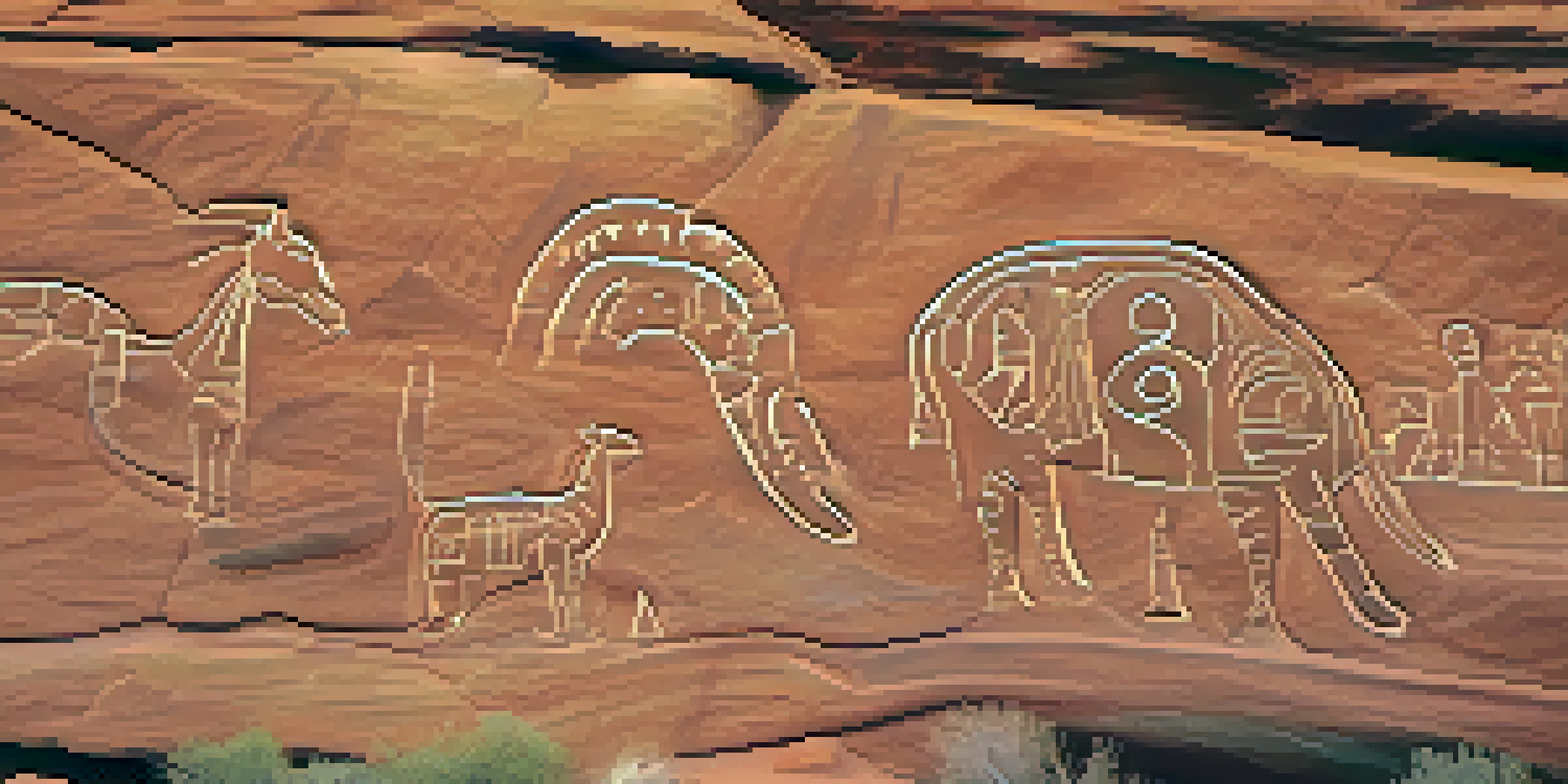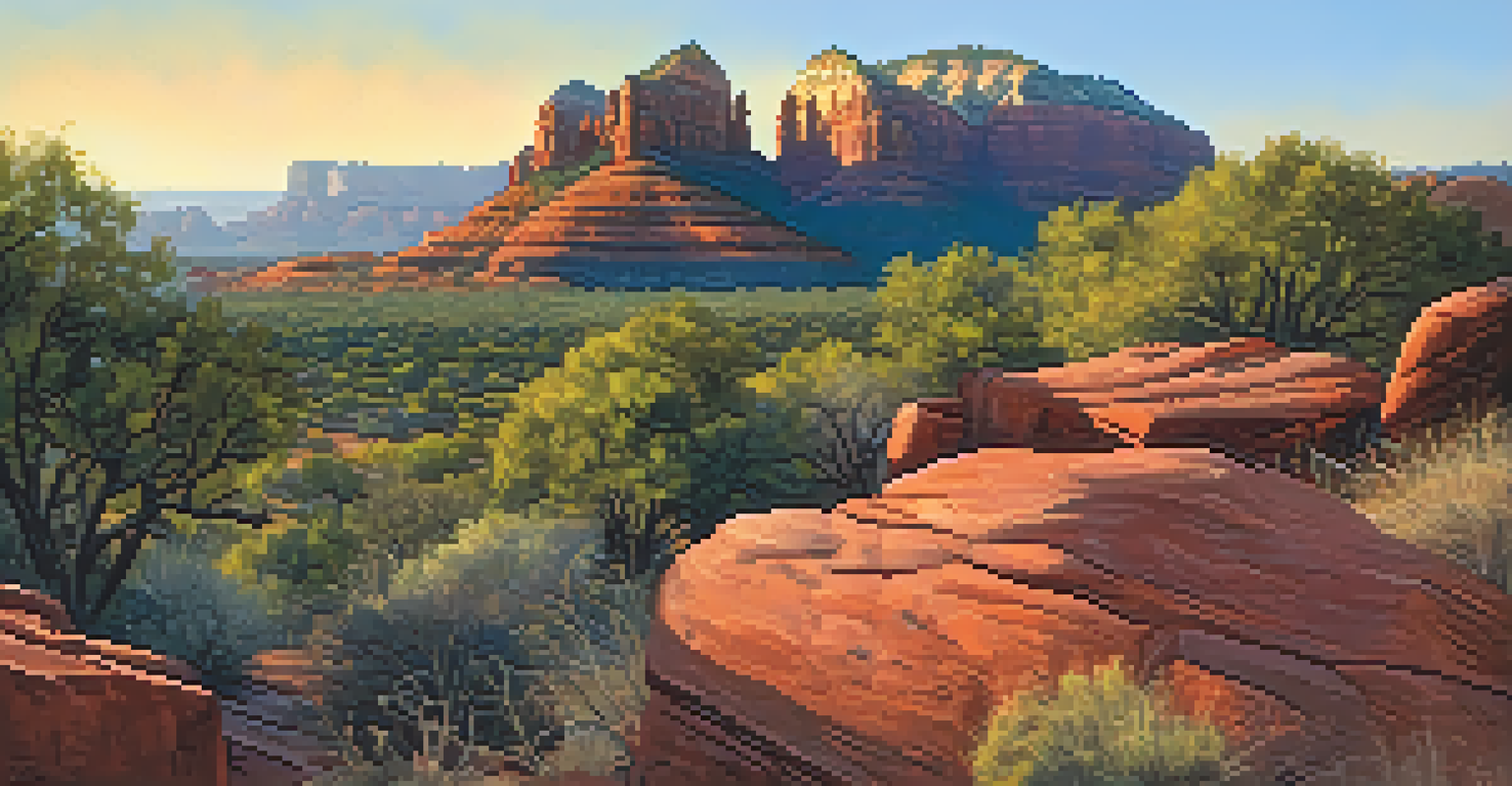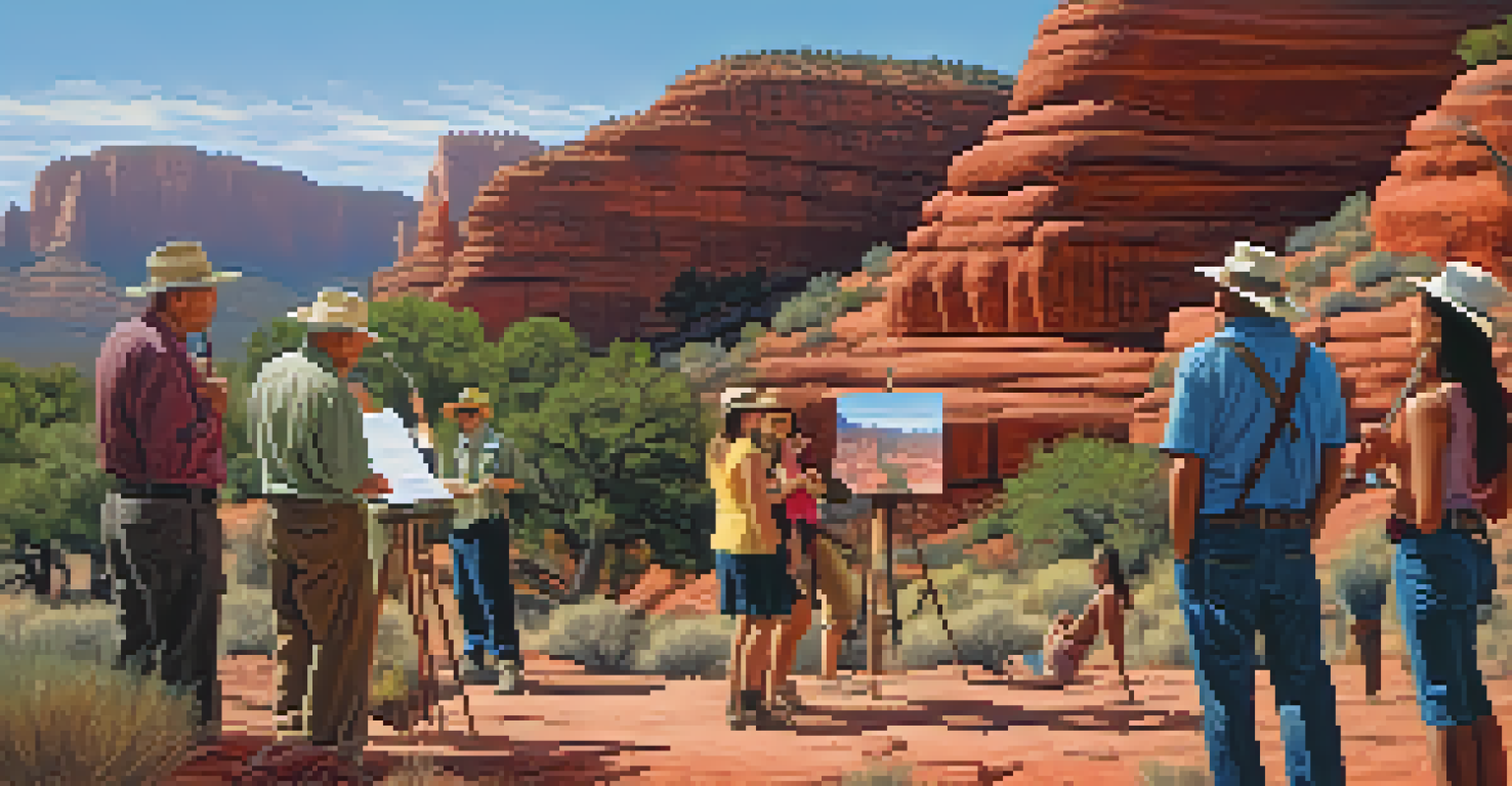Petroglyphs of Sedona: Unlocking Ancient Native American Stories

Introduction to Sedona's Petroglyphs and Their Significance
Nestled in the stunning red rock formations of Sedona, Arizona, petroglyphs offer a glimpse into the lives of ancient Native American cultures. These rock carvings, created thousands of years ago, are not just art; they are historical narratives that tell stories of the people who once roamed these lands. Understanding these symbols allows us to connect with the rich heritage of the area.
Art is the most beautiful of all lies; it is a dream that depicts reality.
Each petroglyph is a testament to the creativity and spirituality of its creators, often depicting animals, human figures, and geometric shapes. These images were created using tools like stones and chisels, and they often served as markers for important events, territorial boundaries, or spiritual beliefs. The intricate designs reflect the deep connection that Native Americans had with nature and their environment.
Visiting these sites today is like stepping back in time, as the petroglyphs still hold the power to evoke emotion and curiosity. They encourage us to ponder the stories behind them, making Sedona a living museum of ancient culture. As we delve deeper into the world of these carvings, we uncover layers of meaning that continue to resonate with people today.
The Cultures Behind Sedona's Petroglyphs
The petroglyphs of Sedona are primarily attributed to the Sinagua people, who inhabited the region from around 500 to 1425 AD. This group is known for their agricultural practices, intricate pottery, and, of course, their remarkable rock art. Understanding the Sinagua culture provides context to the symbols we see today, allowing us to appreciate their significance.

In addition to the Sinagua, other tribes such as the Hopi and Zuni have also contributed to the region's petroglyph legacy. Each tribe brought its own perspective and artistic style, enriching the tapestry of stories told through these carvings. As we explore these diverse influences, we begin to see how interconnected these cultures were with one another and their shared environment.
Cultural Significance of Petroglyphs
Sedona's petroglyphs serve as historical narratives that connect us to the ancient Native American cultures and their deep respect for nature.
These petroglyphs were often created as part of rituals or celebrations, serving not just as art but as a means of communication and expression. They reflect the values, beliefs, and experiences of the tribes, showcasing their deep respect for the land and its resources. This cultural significance adds another layer of richness to the experience of viewing these ancient symbols.
Common Themes in Sedona's Petroglyphs
One of the most striking aspects of Sedona's petroglyphs is their recurring themes, many of which center around nature, spirituality, and daily life. For instance, animals often represent important totems or guides in Native American cultures, embodying qualities such as strength or wisdom. By studying these symbols, we gain insight into how the ancients viewed the world around them.
The past is never dead. It's not even past.
Another common theme is the depiction of human figures engaged in various activities, from hunting to dancing. These images often serve as visual storytelling, capturing significant moments in the lives of the people. They offer a glimpse into the social and spiritual practices that defined their existence, thus enriching our understanding of their community life.
Additionally, geometric shapes can be found throughout the petroglyphs, often symbolizing the cycles of life or cosmic elements. These patterns not only enhance the aesthetic quality of the carvings but also convey deeper philosophical meanings. By examining these themes, we can appreciate the complexity and depth of the stories told through these ancient artworks.
The Artistry of Petroglyphs: Techniques and Styles
Creating petroglyphs is an art form that involves both skill and creativity, and the techniques used by Native Americans varied greatly. The most common method was pecking, where small stones were used to chip away at the rock surface, creating the desired designs. This technique required patience and precision, as the artisans sought to bring their visions to life.
Different styles emerged based on cultural influences, geography, and the time period in which they were created. For instance, some petroglyphs feature intricate patterns and detailed figures, while others are more simplistic and abstract. These stylistic differences help researchers identify the origins and age of the carvings, contributing to our understanding of the region's history.
Artistry and Techniques in Carving
The creation of petroglyphs showcases a variety of artistic techniques and styles, reflecting the skill and creativity of the ancient artisans.
The choice of rock surface also played a significant role in the artistry of petroglyphs. Sedona’s soft sandstone offered an ideal canvas for carving, allowing for both fine detail and lasting impressions. This attention to material and technique highlights the artistry and dedication of the creators, making each petroglyph a unique work of cultural significance.
Preservation Efforts for Sedona's Petroglyphs
As we continue to explore and appreciate the petroglyphs of Sedona, it becomes imperative to discuss preservation efforts. These ancient artworks are vulnerable to weathering, vandalism, and natural erosion, making it essential to protect them for future generations. Local tribes, archaeologists, and conservationists have joined forces to ensure that these cultural treasures are safeguarded.
Educational programs and guided tours have also been developed to promote awareness about the importance of these petroglyphs. By teaching visitors about their historical and cultural significance, we can foster a sense of respect and stewardship for these ancient sites. Engaging the community is crucial in preserving not just the petroglyphs but also the stories they tell.
Moreover, responsible tourism plays a key role in preservation. Visitors are encouraged to remain on designated paths, avoid touching the carvings, and report any damage or vandalism. By practicing mindfulness and respect while visiting these sites, we can all contribute to the ongoing protection of Sedona's petroglyphs and the rich history they embody.
Visiting Sedona's Petroglyph Sites: What to Expect
If you're planning to visit Sedona to see these stunning petroglyphs, prepare for an unforgettable experience. Many sites are easily accessible, offering well-marked trails that guide you to view the carvings up close. As you hike through the breathtaking landscape, you’ll be surrounded by the same natural beauty that inspired the ancient artists.
During your visit, consider joining a guided tour led by knowledgeable local experts. These tours often provide insights that deepen your understanding of the petroglyphs, sharing stories and cultural context that bring the carvings to life. You'll leave with a greater appreciation for the artistry and history behind each symbol.
Importance of Preservation Efforts
Protecting Sedona's petroglyphs from erosion and vandalism is crucial for maintaining the cultural heritage they represent for future generations.
Remember to bring your camera but be mindful of the preservation guidelines. While capturing the beauty of the petroglyphs is tempting, it's essential to respect the sacredness of these sites. By doing so, you ensure that future visitors can also enjoy the magic of Sedona's ancient storytelling.
Conclusion: The Lasting Legacy of Sedona's Petroglyphs
The petroglyphs of Sedona serve as an enduring connection to the past, allowing us to unlock the stories of ancient Native American cultures. These incredible artworks remind us of the human experience across time, the shared values of creativity, spirituality, and connection to the earth. They invite us to reflect on our own relationship with nature and history.
As we continue to explore and learn from these petroglyphs, it’s vital that we honor and protect the legacy they represent. Each carving is a voice from the past, telling tales that have shaped the cultural landscape of Sedona. By preserving these sites, we ensure that future generations can also connect with this rich heritage.

In a world that often feels disconnected from its roots, the petroglyphs remind us of the importance of storytelling. They encourage us to listen to the whispers of history, to appreciate the artistry that has survived through the ages, and to cherish the cultural narratives that bind us all together.